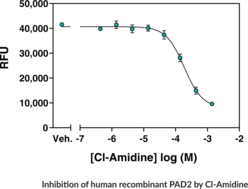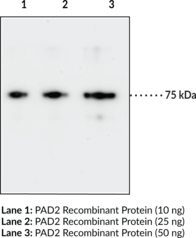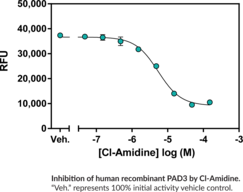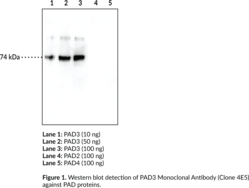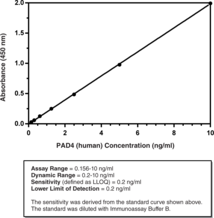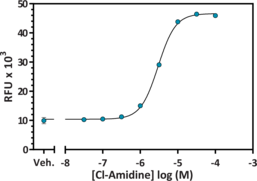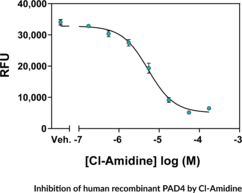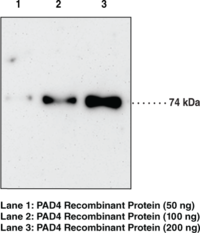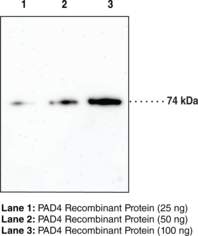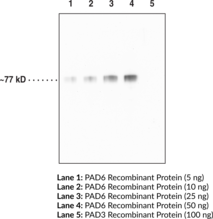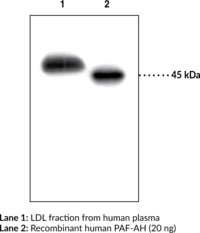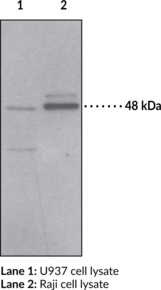Cayman
Showing 33751–33900 of 45550 results
-
Protein Arginine Deiminase 2 (PAD2) is a guanidino-modifying enzyme that catalyzes the conversion of specific arginine residues to citrulline in a calcium-dependent manner. This enzyme has been implicated in several diseases, including rheumatoid arthritis (RA), retinal degeneration, and certain cancers. PAD2 has been shown to modify vimentin, fibrinogen and β/γ-actin. Extracellular levels of PAD2 are increased in the lungs of smokers, providing a link between smoking as a risk factor for RA and anti-citrullinated protein antibodies among RA patients. Cayman’s PAD2 Inhibitor Screening Assay (Ammonia) provides a convenient method for screening human PAD2 inhibitors.
Brand:CaymanSKU:701400 - 96 wellsAvailable on backorder
Immunogen: Full length recombinant human PAD2 protein • Clone: 9F7 • Host: Mouse • Isotype: IgG1 Species Reactivity: (+) Human • Applications: ELISA, IHC, and WB
Brand:CaymanSKU:19822- 100 µgAvailable on backorder
Immunogen: Full length recombinant human PAD2 protein • Clone: 9F7 • Host: Mouse • Isotype: IgG1 Species Reactivity: (+) Human • Applications: ELISA, IHC, and WB
Brand:CaymanSKU:19822- 100 µgProtein Arginine Deiminases (PADs) are guanidino-modifying enzymes belonging to the amidinotransferase superfamily and are designated PAD1-4 and PAD6. PAD enzymes catalyze the conversion of specific arginine residues to citrulline in a calcium-dependent manner. All enzymes are cytosolic except for PAD4 which is localized in the nucleus.{18141} PAD2 is the most widely expressed member and also the most conserved across mammalian species, implying it is the ancestral homologue of the PADs.{19489} Overexpression of PAD2 results in myelin loss in a transgenic model, potentially linking PAD2 activity to multiple sclerosis.{30727} It has also been shown to modify vimentin and β/γ-actin, potentially aggravating the autoantigen response in rheumatoid arthritis.{30728,30130} PAD2 may also play a role in transcriptional regulation, as it has been shown capable of citrullinating histones, particularly H3 during mammalian reproductive cycles, when it is transcriptionally activated in the nucleus.{30729} The predicted molecular weight of PAD2 is 75.6 kDa and Cayman’s PAD2 Monoclonal Antibody (Clone 9F7) detects a band at 75 kDa by western blot.
Brand:CaymanSKU:19822 - 100 µgAvailable on backorder
Cayman’s PAD3 Inhibitor Screening Assay Kit (Ammonia) provides a convenient method for screening human PAD3 inhibitors. PAD3 deiminates N-α-benzoyl-L-arginine ethyl ester (BAEE), a non-natural substrate with similar kinetic properties to the natural substrates, producing ammonia.{18133} Ammonia reacts with a detector resulting in a fluorescent product. Fluorescence is then analyzed with an excitation wavelength of 405-415 nm and an emission wavelength of 470-480 nm.
Brand:CaymanSKU:701470 - 96 wellsAvailable on backorder
Protein arginine deiminase 3 (PAD3; Item No. 10786) is a homodimeric guanidine-modifying enzyme belonging to the amidinotransferase superfamily.{34555} It is a calcium-dependent enzyme that catalyzes the post-translational modification of target proteins by converting arginine to citrulline. Substrates of PAD3 include filaggrin, trichohyalin, apoptosis-inducing factor (AIF), vimentin, and other proteins.{34556} PAD3 is expressed in the epidermis, hair follicles, and keratinocytes. It has a role in shaping and mechanical strengthening of hair, and mutations in PAD3 lead to uncombable hair syndrome.{36391} PAD3 is also expressed in mammary glands and citrullinates proteins during lactation.{34764} Cayman’s PAD3 Monoclonal Antibody (Clone 4E5) can be used for Western blot and ELISA. The predicted size for PAD3 is 76.4 kDa and Cayman’s PAD3 Monoclonal Antibody (Clone 4E5) recognizes PAD3 at ~74 kDa from human samples.
Brand:CaymanSKU:24377 - 100 µgAvailable on backorder
Immunogen: Full length recombinant PAD3 protein • Clone designation: 4E5 • Host: Mouse • Cross reactivity: (+) PAD3; (-) PAD1, PAD2, PAD4 • Species Reactivity: (+) Human • Isotype: IgG1 • Applications: ELISA and WB,
Brand:CaymanSKU:24377- 100 µgAvailable on backorder
Immunogen: Full length recombinant PAD3 protein • Clone designation: 4E5 • Host: Mouse • Cross reactivity: (+) PAD3; (-) PAD1, PAD2, PAD4 • Species Reactivity: (+) Human • Isotype: IgG1 • Applications: ELISA and WB,
Brand:CaymanSKU:24377- 100 µgBrand:CaymanSKU:700562 - 60 µlAvailable on backorder
Peptidyl arginine deiminases (PADs) are a family of five enzymes that catalyzes the conversion of arginine to citrulline in peptides and proteins.{31654} PAD4 is in the nucleus of neutrophils and monocytes, and other hematopoietic cells. Cayman’s PAD4 (human) ELISA Kit is a sandwich assay that can be used to measure PAD4 in tissue culture medium, cell lysates, plasma, and serum.
Brand:CaymanSKU:501460 - 96 WellAvailable on backorder
Protein arginine deiminase 4 (PAD4) is a guanidino-modifying enzyme that functions as a transcriptional coregulator catalyzing the conversion of specific arginine residues to citrulline. Substrates for PAD4 include histones H2A, H3, and H4. PAD4 autocitrullinates itself at several sites, inhibiting its enzymatic activity. PAD4 activity is increased in rheumatoid arthritis, producing an abundance of citrulline-containing proteins that generate an immune response resulting in production of autoantibodies that ultimately attack the host tissues. PAD4 has also been implicated in several other diseases including multiple sclerosis, Alzheimer’s disease, glaucoma, and cancer. Cayman’s PAD4 Inhibitor Screening Assay (AMC) provides a convenient, fluorescence-based method for screening human PAD4 inhibitors.
Brand:CaymanSKU:701320 - 96 wellsAvailable on backorder
Protein Arginine Deiminase 4 (PAD4) is a guanidino-modifying enzyme that functions as a transcriptional coregulator catalyzing the conversion of specific arginine residues to citrulline. Substrates for PAD4 include histones H2A, H3, and H4. PAD4 autocitrullinates itself at several sites, inhibiting its enzymatic activity. PAD4 activity is increased in rheumatoid arthritis, producing an abundance of citrulline-containing proteins that generate an immune response resulting in production of autoantibodies that ultimately attack the host tissues. PAD4 has also been implicated in several other diseases including multiple sclerosis, Alzheimer’s disease, glaucoma, and cancer. Cayman’s PAD4 Inhibitor Screening Assay (Ammonia) provides a convenient, fluorescence-based method for screening human PAD4 inhibitors.
Brand:CaymanSKU:700560 - 96 wellsAvailable on backorder
Immunogen: Full length recombinant PAD4 protein • Clone: 11F9 • Host: Mouse • Isotype: IgG1 Species Reactivity: (+) Human • Applications: ELISA, WB
Brand:CaymanSKU:19671- 100 µgAvailable on backorder
Immunogen: Full length recombinant PAD4 protein • Clone: 11F9 • Host: Mouse • Isotype: IgG1 Species Reactivity: (+) Human • Applications: ELISA, WB
Brand:CaymanSKU:19671- 100 µgProtein arginine deiminases (PADs) are guanidino-modifying enzymes belonging to the amidinotransferase superfamily and are designated PAD1-4 and PAD6. All enzymes are cytosolic except for PAD4 which is localized in the nucleus.{18141} PAD4 is a homodimer that functions as a transcriptional coregulator to catalyze the conversion of specific arginine residues to citrulline in a calcium-dependent manner. PAD4 substrates include histones H2A, H3, and H4, whose post-translational modifications play a large role in gene regulation.{18134} Benzoylated arginine substrates like N-α-benzoyl-L-arginine ethyl ester have proven to be useful tools for characterization of PAD4, having similar kinetic properties to the natural substrates.{18133} PAD4 itself can undergo autocitrullination at several sites, which inhibits its enzymatic activity and may play an important role in regulating citrullination in cells.{18135} PAD4 activity is increased in rheumatoid arthritis, producing an abundance of citrulline-containing proteins that can be recognized by autoantibodies, causing the immune system to attack its own tissues.{18137} PAD4 has also been implicated in several other diseases including multiple sclerosis, Alzheimer’s, glaucoma, and cancer.{18134} The predicted size of PAD4 is 74.1 kDa and Cayman’s PAD4 Monoclonal Antibody (Clone 11F9) detects a band at 74 kDa by western blot.
Brand:CaymanSKU:19671 - 100 µgAvailable on backorder
Immunogen: Full length recombinant PAD4 protein • Clone: 6D8 • Host: Mouse • Isotype: IgG1 • Species Reactivity: (+) Human • Applications: ELISA, WB
Brand:CaymanSKU:19669- 100 µgAvailable on backorder
Immunogen: Full length recombinant PAD4 protein • Clone: 6D8 • Host: Mouse • Isotype: IgG1 • Species Reactivity: (+) Human • Applications: ELISA, WB
Brand:CaymanSKU:19669- 100 µgProtein arginine deiminases (PADs) are guanidino-modifying enzymes belonging to the amidinotransferase superfamily and are designated PAD1-4 and PAD6. All enzymes are cytosolic except for PAD4 which is localized in the nucleus.{18141} PAD4 is a homodimer that functions as a transcriptional coregulator to catalyze the conversion of specific arginine residues to citrulline in a calcium-dependent manner. PAD4 substrates include histones H2A, H3, and H4, whose post-translational modifications play a large role in gene regulation.{18134} Benzoylated arginine substrates like N-α-benzoyl-L-arginine ethyl ester have proven to be useful tools for characterization of PAD4, having similar kinetic properties to the natural substrates.{18133} PAD4 itself can undergo autocitrullination at several sites, which inhibits its enzymatic activity and may play an important role in regulating citrullination in cells.{18135} PAD4 activity is increased in rheumatoid arthritis, producing an abundance of citrulline-containing proteins that can be recognized by autoantibodies, causing the immune system to attack its own tissues.{18137} PAD4 has also been implicated in several other diseases including multiple sclerosis, Alzheimer’s, glaucoma, and cancer.{18134} The predicted size of PAD4 is 74.1 kDa and Cayman’s PAD4 Monoclonal Antibody (Clone 6D8) detects a band at 74 kDa by western blot.
Brand:CaymanSKU:19669 - 100 µgAvailable on backorder
Protein arginine deiminase 6 (PAD6) is a homodimeric guanidine-modifying enzyme belonging to the amidinotransferase superfamily.{34555} It is a calcium-dependent enzyme that catalyzes the post-translational modification of target proteins by converting arginine to citrulline. PAD6 is expressed in mammalian oocytes, sperm cells, and early embryos.{39678} In mammalian oocytes and early embryo cytoplasm, its expression is localized to cytoskeletal sheets, dynamic structures containing various keratins, which are major targets for citrullination. PAD6-/- oocytes exhibit reduced microtubule acetylation and defective organelle positioning and redistribution, suggesting a role for PAD6 in regulating microtubule-mediated organelle movement and positioning.{39677} PAD6-/- female, but not male, mice are infertile due to a reduction of de novo protein synthesis, cytoskeletal sheet formation, and ribosomal RNA which induces arrest of zygote development at the two-cell stage.{39678,39679} PAD6 is regulated by newborn ovary homeobox (Nobox), as its promoter contains a Nobox DNA-binding element (NBE) and expression and activity of PAD6 are decreased in Nobox-/- mouse ovaries.{39676} In human females, homozygous nonsense mutations and compound-heterozygous mutations in PAD6 induce early embryonic arrest following in vitro fertilization (IVF) or intracytoplasmic sperm injection (ICSI).{39680} Cayman’s PAD6 monoclonal antibody (Clone 4B7) can be used for Western blot and ELISA applications. The antibody recognizes PAD6 at ~77 kDa from human samples.
Brand:CaymanSKU:25965 - 100 µgAvailable on backorder
Immunogen: Full-length recombinant PAD6 protein • Host: Mouse • Cross reactivity: (-) PAD1, PAD2, PAD3, PAD4 • Species Reactivity: (+) Human PAD6 • Isotype: IgG1 • Applications: ELISA and WB • MW = ~77 kDa
Brand:CaymanSKU:25965- 100 µgAvailable on backorder
Immunogen: Full-length recombinant PAD6 protein • Host: Mouse • Cross reactivity: (-) PAD1, PAD2, PAD3, PAD4 • Species Reactivity: (+) Human PAD6 • Isotype: IgG1 • Applications: ELISA and WB • MW = ~77 kDa
Brand:CaymanSKU:25965- 100 µgPadanamide A is a bacterial metabolite originally isolated from a marine Streptomyces species.{42129} It is active against five strains of P. falciparum (EC50s = 160-340 nM), is not cytotoxic to HEK293 or HepG2 human cell lines, but is cytotoxic to Jurkat T lymphocytes with an IC50 value of approximately 60 µg/ml.{42130,42131}
Brand:CaymanSKU:25085 - 1 mgAvailable on backorder
Padanamide A is a bacterial metabolite originally isolated from a marine Streptomyces species.{42129} It is active against five strains of P. falciparum (EC50s = 160-340 nM), is not cytotoxic to HEK293 or HepG2 human cell lines, but is cytotoxic to Jurkat T lymphocytes with an IC50 value of approximately 60 µg/ml.{42130,42131}
Brand:CaymanSKU:25085 - 5 mgAvailable on backorder
Paeoniflorin is a monoterpene glycoside first isolated from the roots of peony. It has diverse cellular actions, including modulating NMDA and TRPV1 receptors.{31755,31756} Paeoniflorin is reported to inhibit testosterone synthesis and stimulate aromatase activity.{31757} It also reduces inflammatory signaling by inhibiting p38 MAP kinase and blocks pancreatic cancer cell apoptosis by suppressing MMP-9 and ERK signaling.{31758,31759,31760} Presumably through some of these actions, paeoniflorin has analgesic and anti-inflammatory actions in mice.
Brand:CaymanSKU:19861 -Available on backorder
Paeoniflorin is a monoterpene glycoside first isolated from the roots of peony. It has diverse cellular actions, including modulating NMDA and TRPV1 receptors.{31755,31756} Paeoniflorin is reported to inhibit testosterone synthesis and stimulate aromatase activity.{31757} It also reduces inflammatory signaling by inhibiting p38 MAP kinase and blocks pancreatic cancer cell apoptosis by suppressing MMP-9 and ERK signaling.{31758,31759,31760} Presumably through some of these actions, paeoniflorin has analgesic and anti-inflammatory actions in mice.
Brand:CaymanSKU:19861 -Available on backorder
Paeoniflorin is a monoterpene glycoside first isolated from the roots of peony. It has diverse cellular actions, including modulating NMDA and TRPV1 receptors.{31755,31756} Paeoniflorin is reported to inhibit testosterone synthesis and stimulate aromatase activity.{31757} It also reduces inflammatory signaling by inhibiting p38 MAP kinase and blocks pancreatic cancer cell apoptosis by suppressing MMP-9 and ERK signaling.{31758,31759,31760} Presumably through some of these actions, paeoniflorin has analgesic and anti-inflammatory actions in mice.
Brand:CaymanSKU:19861 -Available on backorder
Paeoniflorin is a monoterpene glycoside first isolated from the roots of peony. It has diverse cellular actions, including modulating NMDA and TRPV1 receptors.{31755,31756} Paeoniflorin is reported to inhibit testosterone synthesis and stimulate aromatase activity.{31757} It also reduces inflammatory signaling by inhibiting p38 MAP kinase and blocks pancreatic cancer cell apoptosis by suppressing MMP-9 and ERK signaling.{31758,31759,31760} Presumably through some of these actions, paeoniflorin has analgesic and anti-inflammatory actions in mice.
Brand:CaymanSKU:19861 -Available on backorder
Paeonol is a phenol that has been found in Paeonia and has diverse biological activities.{31764,58139,31762,31761} It inhibits LPS- and IFN-γ-induced migration and production of reactive oxygen species (ROS) in BV-2 microglia when used at concentrations of 10 and 30 µM.{31764} Paeonol inhibits histamine release from rat peritoneal mast cells induced by compound 48/80 (Item No. 22173) and reduces mortality in a mouse model of compound 48/80-induced anaphylactic shock when administered at a dose of 0.5 mg per animal.{58139} It reduces hepatic necrosis and serum levels of alanine aminotransferase (ALT) and aspartate aminotransferase (AST) in a mouse model of hepatotoxicity induced by acetaminophen (Item No. 10024) when administered at a dose of 100 mg/kg.{31762} Paeonol (30, 50, and 100 mg/kg) inhibits carrageenan-induced thermal hyperalgesia and production of nitric oxide (NO) and prostaglandin E2 (PGE2; Item No. 14010) in rats.{31761}
Brand:CaymanSKU:19862 -Available on backorder
Paeonol is a phenol that has been found in Paeonia and has diverse biological activities.{31764,58139,31762,31761} It inhibits LPS- and IFN-γ-induced migration and production of reactive oxygen species (ROS) in BV-2 microglia when used at concentrations of 10 and 30 µM.{31764} Paeonol inhibits histamine release from rat peritoneal mast cells induced by compound 48/80 (Item No. 22173) and reduces mortality in a mouse model of compound 48/80-induced anaphylactic shock when administered at a dose of 0.5 mg per animal.{58139} It reduces hepatic necrosis and serum levels of alanine aminotransferase (ALT) and aspartate aminotransferase (AST) in a mouse model of hepatotoxicity induced by acetaminophen (Item No. 10024) when administered at a dose of 100 mg/kg.{31762} Paeonol (30, 50, and 100 mg/kg) inhibits carrageenan-induced thermal hyperalgesia and production of nitric oxide (NO) and prostaglandin E2 (PGE2; Item No. 14010) in rats.{31761}
Brand:CaymanSKU:19862 -Available on backorder
Paeonol is a phenol that has been found in Paeonia and has diverse biological activities.{31764,58139,31762,31761} It inhibits LPS- and IFN-γ-induced migration and production of reactive oxygen species (ROS) in BV-2 microglia when used at concentrations of 10 and 30 µM.{31764} Paeonol inhibits histamine release from rat peritoneal mast cells induced by compound 48/80 (Item No. 22173) and reduces mortality in a mouse model of compound 48/80-induced anaphylactic shock when administered at a dose of 0.5 mg per animal.{58139} It reduces hepatic necrosis and serum levels of alanine aminotransferase (ALT) and aspartate aminotransferase (AST) in a mouse model of hepatotoxicity induced by acetaminophen (Item No. 10024) when administered at a dose of 100 mg/kg.{31762} Paeonol (30, 50, and 100 mg/kg) inhibits carrageenan-induced thermal hyperalgesia and production of nitric oxide (NO) and prostaglandin E2 (PGE2; Item No. 14010) in rats.{31761}
Brand:CaymanSKU:19862 -Available on backorder
Paeonol is a phenol that has been found in Paeonia and has diverse biological activities.{31764,58139,31762,31761} It inhibits LPS- and IFN-γ-induced migration and production of reactive oxygen species (ROS) in BV-2 microglia when used at concentrations of 10 and 30 µM.{31764} Paeonol inhibits histamine release from rat peritoneal mast cells induced by compound 48/80 (Item No. 22173) and reduces mortality in a mouse model of compound 48/80-induced anaphylactic shock when administered at a dose of 0.5 mg per animal.{58139} It reduces hepatic necrosis and serum levels of alanine aminotransferase (ALT) and aspartate aminotransferase (AST) in a mouse model of hepatotoxicity induced by acetaminophen (Item No. 10024) when administered at a dose of 100 mg/kg.{31762} Paeonol (30, 50, and 100 mg/kg) inhibits carrageenan-induced thermal hyperalgesia and production of nitric oxide (NO) and prostaglandin E2 (PGE2; Item No. 14010) in rats.{31761}
Brand:CaymanSKU:19862 -Available on backorder
Immunogen: Synthetic peptide from the C-terminal region of human PAF-AH • Host: Rabbit • Species Reactivity: (+) Human; (−) Mouse • Application(s): IHC and WB
Brand:CaymanSKU:160603- 500 µlPAF Acetylhydrolase (PAF-AH) catalyzes the hydrolysis of the acetyl group at the sn-2 position of PAF to yield lyso-PAF and acetate, thereby inactivating PAF. Two main types of PAF-AH have been characterized, namely secreted (i.e., plasma) and intracellular enzymes, which are encoded on individual genes and share only 41% homology at the amino acid level.{4758,2618,6501} Plasma PAF-AH is a 45.4 kDa enzyme which is associated with the LDL fraction of plasma.{2618,2626}
Brand:CaymanSKU:160603 - 500 µlAvailable on backorder
Immunogen: Synthetic peptide from the C-terminal region of human PAF-AH • Host: Rabbit • Species Reactivity: (+) Human; (−) Mouse • Application(s): IHC and WB
Brand:CaymanSKU:160603- 500 µlAvailable on backorder
Brand:CaymanSKU:760910 - 1 eaAvailable on backorder
Brand:CaymanSKU:760911 - 1 eaAvailable on backorder
Platelet-activating factor (PAF) is a biologically active phospholipid synthesized by a variety of cells upon stimulation. PAF is converted to the biologically inactive lyso-PAF by the enzyme PAF acetylhydrolase (PAF-AH). Plasma PAF-AH is highly selective for phospholipids with very short acyl groups at the sn-2 position and is associated with lipoproteins.{2626} The Cayman Chemical PAF acetylhydrolase assay kit provides an accurate and convenient method for measurement of PAF-AH activity. The assay uses 2-thio PAF which serves as a substrate for PAF-AH.{3787} Upon hydrolysis of the acetyl thioester bond at the sn-2 position by PAF-AH, free thiols are detected using 5,5′-dithio-bis(2-nitrobenzoic acid) (DTNB; Ellman’s reagent). The dynamic range of the assay is only limited by the accuracy of the absorbance measurement. Most plate readers are linear to an absorbance of 1.2. The detection range of the assay is from 0.02 to 0.2 µmol/min/ml of PAF-AH activity which is equivalent to an absorbance increase of 0.01 to 0.1 per minute. Each kit contains assay buffer, DTNB, 2-thio PAF (substrate), human PAF-AH standard, a 96 well plate, and complete instructions.
Brand:CaymanSKU:760901 - 96 wellsAvailable on backorder
Platelet-activating factor (PAF) is a biologically active phospholipid synthesized by a variety of stimulated cells. The biological effects of PAF include activation of platelets, polymorphonuclear leukocytes, monocytes, and macrophages. PAF also increases vascular permeability, decreases cardiac output, induces hypotension, and stimulates uterine contraction.{939} PAF has been implicated in pathological processes, such as inflammation and allergy.{11753} PAF is converted to the biologically inactive lyso-PAF by the enzyme PAF acetylhydrolase (PAF-AH). PAF-AHs are located intra- and extra-cellularly (e.g., cytosolic and plasma). Plasma PAF-AH is highly selective for phospholipids with very short acyl groups at the sn-2 position and is associated with lipoproteins.{2626} Recently, plasma PAF-AH has been linked to atherosclerosis and may be a positive risk factor for coronary heart disease in humans.{11455} The Cayman Chemical PAF Acetylhydrolase Inhibitor Screening Assay uses 2-thio PAF as a substrate for PAF-AH.{3787} Upon hydrolysis of the acetyl thioester bond at the sn-2 position by PAF-AH, free thiols are detected using 5,5′-dithio-bis-(2-nitrobenzoic acid) also known as DTNB or Ellman’s reagent. Cayman’s PAF-AH Inhibitor Screening assay includes human plasma PAF-AH and is a time saving tool for screening vast numbers of inhibitors.
Brand:CaymanSKU:10004380 - 96 wellsAvailable on backorder
PAF C-16 is a naturally occurring phospholipid produced upon stimulation through two distinct pathways known as the “remodeling” and ‘de novo’ pathways.{939} It is a potent mediator of neutrophil migration,{1437} and the production of reactive oxygen species, and IL-6 in human macrophages.{367,2296} It is a more potent mediator of platelet aggregation than PAF C-18.{3786} Pathological processes involving PAF include necrotizing enterocolitis,{5841} inflammation, asthma, and allergy.{303}
Brand:CaymanSKU:60900 - 1 mgAvailable on backorder
PAF C-16 is a naturally occurring phospholipid produced upon stimulation through two distinct pathways known as the “remodeling” and ‘de novo’ pathways.{939} It is a potent mediator of neutrophil migration,{1437} and the production of reactive oxygen species, and IL-6 in human macrophages.{367,2296} It is a more potent mediator of platelet aggregation than PAF C-18.{3786} Pathological processes involving PAF include necrotizing enterocolitis,{5841} inflammation, asthma, and allergy.{303}
Brand:CaymanSKU:60900 - 10 mgAvailable on backorder
PAF C-16 is a naturally occurring phospholipid produced upon stimulation through two distinct pathways known as the “remodeling” and ‘de novo’ pathways.{939} It is a potent mediator of neutrophil migration,{1437} and the production of reactive oxygen species, and IL-6 in human macrophages.{367,2296} It is a more potent mediator of platelet aggregation than PAF C-18.{3786} Pathological processes involving PAF include necrotizing enterocolitis,{5841} inflammation, asthma, and allergy.{303}
Brand:CaymanSKU:60900 - 25 mgAvailable on backorder
PAF C-16 is a naturally occurring phospholipid produced upon stimulation through two distinct pathways known as the “remodeling” and ‘de novo’ pathways.{939} It is a potent mediator of neutrophil migration,{1437} and the production of reactive oxygen species, and IL-6 in human macrophages.{367,2296} It is a more potent mediator of platelet aggregation than PAF C-18.{3786} Pathological processes involving PAF include necrotizing enterocolitis,{5841} inflammation, asthma, and allergy.{303}
Brand:CaymanSKU:60900 - 5 mgAvailable on backorder
PAF C-16 is a naturally occurring phospholipid produced upon stimulation through two distinct pathways known as the “remodeling” and ‘de novo’ pathways.{939} It is a potent mediator of neutrophil migration and the production of reactive oxygen species and IL-6.{1437,367,2296} Pathological processes involving PAF include necrotizing enterocolitis, inflammation, asthma, and allergy.{5841,303} PAF C-16 Carboxylic acid is modified with a carboxylic acid group terminating the C-16 alkyl chain. This provides a convenient site for chemical crosslinking.
Brand:CaymanSKU:-PAF C-16 is a naturally occurring phospholipid produced upon stimulation through two distinct pathways known as the “remodeling” and ‘de novo’ pathways.{939} It is a potent mediator of neutrophil migration and the production of reactive oxygen species and IL-6.{1437,367,2296} Pathological processes involving PAF include necrotizing enterocolitis, inflammation, asthma, and allergy.{5841,303} PAF C-16 Carboxylic acid is modified with a carboxylic acid group terminating the C-16 alkyl chain. This provides a convenient site for chemical crosslinking.
Brand:CaymanSKU:-PAF C-16 is a naturally occurring phospholipid produced upon stimulation through two distinct pathways known as the “remodeling” and ‘de novo’ pathways.{939} It is a potent mediator of neutrophil migration and the production of reactive oxygen species and IL-6.{1437,367,2296} Pathological processes involving PAF include necrotizing enterocolitis, inflammation, asthma, and allergy.{5841,303} PAF C-16 Carboxylic acid is modified with a carboxylic acid group terminating the C-16 alkyl chain. This provides a convenient site for chemical crosslinking.
Brand:CaymanSKU:-PAF C-16 is a naturally occurring phospholipid produced upon stimulation through two distinct pathways known as the “remodeling” and ‘de novo’ pathways.{939} It is a potent mediator of neutrophil migration and the production of reactive oxygen species and IL-6.{1437,367,2296} Pathological processes involving PAF include necrotizing enterocolitis, inflammation, asthma, and allergy.{5841,303} PAF C-16 Carboxylic acid is modified with a carboxylic acid group terminating the C-16 alkyl chain. This provides a convenient site for chemical crosslinking.
Brand:CaymanSKU:-PAF C-16-d4 contains four deuterium atoms at the 7, 7′, 8, and 8′ positions of the hexadecyl moiety. It is intended for use as an internal standard for the quantification of PAF C-16 by GC- or LC-mass spectrometry. PAF C-16 is a naturally occurring phospholipid produced upon stimulation through two distinct pathways known as the “remodeling” and ‘de novo’ pathways.{939} It is a potent mediator of neutrophil migration,{1437} the production of reactive oxygen species,{367} and IL-6{2296} in human macrophages. It is a more potent mediator of platelet aggregation than PAF C-18{3786}. Pathological processes involving PAF include necrotizing enterocolitis,{5841} inflammation, asthma, and allergy.{303}
Brand:CaymanSKU:360900 - 1 mgAvailable on backorder
PAF C-16-d4 contains four deuterium atoms at the 7, 7′, 8, and 8′ positions of the hexadecyl moiety. It is intended for use as an internal standard for the quantification of PAF C-16 by GC- or LC-mass spectrometry. PAF C-16 is a naturally occurring phospholipid produced upon stimulation through two distinct pathways known as the “remodeling” and ‘de novo’ pathways.{939} It is a potent mediator of neutrophil migration,{1437} the production of reactive oxygen species,{367} and IL-6{2296} in human macrophages. It is a more potent mediator of platelet aggregation than PAF C-18{3786}. Pathological processes involving PAF include necrotizing enterocolitis,{5841} inflammation, asthma, and allergy.{303}
Brand:CaymanSKU:360900 - 100 µgAvailable on backorder
PAF C-16-d4 contains four deuterium atoms at the 7, 7′, 8, and 8′ positions of the hexadecyl moiety. It is intended for use as an internal standard for the quantification of PAF C-16 by GC- or LC-mass spectrometry. PAF C-16 is a naturally occurring phospholipid produced upon stimulation through two distinct pathways known as the “remodeling” and ‘de novo’ pathways.{939} It is a potent mediator of neutrophil migration,{1437} the production of reactive oxygen species,{367} and IL-6{2296} in human macrophages. It is a more potent mediator of platelet aggregation than PAF C-18{3786}. Pathological processes involving PAF include necrotizing enterocolitis,{5841} inflammation, asthma, and allergy.{303}
Brand:CaymanSKU:360900 - 500 µgAvailable on backorder
PAF C-18 is a naturally occurring phospholipid produced upon stimulation through two distinct pathways known as the “remodeling” and ‘de novo’ pathways.{939} It is less potent than PAF C-16 in the induction of platelet aggregation, but equipotent in activation of guinea pig macrophages.{3786} PAF C-18 induces the release of PGE2 and TXB2 from albumin-elicited guinea pig macrophages, and enhances the spreading of plated macrophages.{640} Pathological processes involving PAF include necrotizing enterocolitis,{5841} inflammation, asthma, and allergy.{303}
Brand:CaymanSKU:60910 - 1 mgAvailable on backorder
PAF C-18 is a naturally occurring phospholipid produced upon stimulation through two distinct pathways known as the “remodeling” and ‘de novo’ pathways.{939} It is less potent than PAF C-16 in the induction of platelet aggregation, but equipotent in activation of guinea pig macrophages.{3786} PAF C-18 induces the release of PGE2 and TXB2 from albumin-elicited guinea pig macrophages, and enhances the spreading of plated macrophages.{640} Pathological processes involving PAF include necrotizing enterocolitis,{5841} inflammation, asthma, and allergy.{303}
Brand:CaymanSKU:60910 - 10 mgAvailable on backorder
PAF C-18 is a naturally occurring phospholipid produced upon stimulation through two distinct pathways known as the “remodeling” and ‘de novo’ pathways.{939} It is less potent than PAF C-16 in the induction of platelet aggregation, but equipotent in activation of guinea pig macrophages.{3786} PAF C-18 induces the release of PGE2 and TXB2 from albumin-elicited guinea pig macrophages, and enhances the spreading of plated macrophages.{640} Pathological processes involving PAF include necrotizing enterocolitis,{5841} inflammation, asthma, and allergy.{303}
Brand:CaymanSKU:60910 - 25 mgAvailable on backorder
PAF C-18 is a naturally occurring phospholipid produced upon stimulation through two distinct pathways known as the “remodeling” and ‘de novo’ pathways.{939} It is less potent than PAF C-16 in the induction of platelet aggregation, but equipotent in activation of guinea pig macrophages.{3786} PAF C-18 induces the release of PGE2 and TXB2 from albumin-elicited guinea pig macrophages, and enhances the spreading of plated macrophages.{640} Pathological processes involving PAF include necrotizing enterocolitis,{5841} inflammation, asthma, and allergy.{303}
Brand:CaymanSKU:60910 - 5 mgAvailable on backorder
PAF C-18:1 is a naturally occurring phospholipid produced by cells upon stimulation and plays a role in the establishment and maintenance of the inflammatory response. It is less potent than PAF C-16 (Item No. 60900) and PAF C-18 (Item No. 60910) in the induction of neutrophil chemotaxis, but is equipotent to PAF C-16 and PAF C-18 in promoting eosinophil migration.{1437,30475} PAF C-18:1 activates the PAF receptor and has been used in antibody binding experiments to determine the importance of an acyl linkage at the sn-2 position for recognition at this receptor.{1629}
Brand:CaymanSKU:-Available on backorder
PAF C-18:1 is a naturally occurring phospholipid produced by cells upon stimulation and plays a role in the establishment and maintenance of the inflammatory response. It is less potent than PAF C-16 (Item No. 60900) and PAF C-18 (Item No. 60910) in the induction of neutrophil chemotaxis, but is equipotent to PAF C-16 and PAF C-18 in promoting eosinophil migration.{1437,30475} PAF C-18:1 activates the PAF receptor and has been used in antibody binding experiments to determine the importance of an acyl linkage at the sn-2 position for recognition at this receptor.{1629}
Brand:CaymanSKU:-Available on backorder
PAF C-18:1 is a naturally occurring phospholipid produced by cells upon stimulation and plays a role in the establishment and maintenance of the inflammatory response. It is less potent than PAF C-16 (Item No. 60900) and PAF C-18 (Item No. 60910) in the induction of neutrophil chemotaxis, but is equipotent to PAF C-16 and PAF C-18 in promoting eosinophil migration.{1437,30475} PAF C-18:1 activates the PAF receptor and has been used in antibody binding experiments to determine the importance of an acyl linkage at the sn-2 position for recognition at this receptor.{1629}
Brand:CaymanSKU:-Available on backorder
Immunogen: Synthetic peptide from the internal region of human PAF receptor • Host: Mouse, 11A4 clone 21 • Species Reactivity: (+) Human, bovine, and porcine PAF receptor • Isotype: IgG2a • Application(s): ELISA, FC, and ICC; does not work for WB • PAF is a biologically active phospholipid whose biological effects include activation of platelets, polymorphonuclear leukocytes, monocytes, and macrophages. PAF increases vascular permeability, decreases cardiac output, induces hypotension, and stimulates uterine contraction.
Brand:CaymanSKU:160600- 1 eaPAF is a potent phospholipid mediator which exerts diverse biological actions by interaction with a G protein-coupled PAF receptor. The PAF receptor has been cloned from a number of species including human, rat, and guinea pig and is characterized as a 7-transmembrane receptor which induces phosphoinositol turnover through G-protein coupling.{5109,5148,5150,5145,5149} Northern blot analysis reveals that the receptor is expressed in leukocytes, placenta, lung, spleen, small intestine, kidney, liver, and brain.{5150,5145} In leukocyte cell populations the receptor is found on platelets, monocytes, neutrophils, and B-cells, whereas resting T-cells and natural killer cell lines do not express the PAF receptor.{4226} Human monocytes treated with INF-γ have a 2-6 fold increase in PAF receptor expression compared to untreated cells.{4225}
Brand:CaymanSKU:160600 - 1 eaAvailable on backorder
Immunogen: Synthetic peptide from the internal region of human PAF receptor • Host: Mouse, 11A4 clone 21 • Species Reactivity: (+) Human, bovine, and porcine PAF receptor • Isotype: IgG2a • Application(s): ELISA, FC, and ICC; does not work for WB • PAF is a biologically active phospholipid whose biological effects include activation of platelets, polymorphonuclear leukocytes, monocytes, and macrophages. PAF increases vascular permeability, decreases cardiac output, induces hypotension, and stimulates uterine contraction.
Brand:CaymanSKU:160600- 1 eaAvailable on backorder
Immunogen: synthetic peptide from the N-terminal region of human protein PAF receptor • Host: rabbit • Species Reactivity: (+) Human and green monkey PAF receptor • Application(s): FC, IHC, and WB • PAF is a biologically active phospholipid whose biological effects include activation of platelets, polymorphonuclear leukocytes, monocytes, and macrophages. PAF increases vascular permeability, decreases cardiac output, induces hypotension, and stimulates uterine contraction.
Brand:CaymanSKU:160602- 1 eaPAF is a potent phospholipid mediator which exerts diverse biological actions by interaction with a G protein-coupled PAF receptor. The PAF receptor has been cloned from a number of species including human, rat, and guinea pig and is characterized as a 7-transmembrane receptor which induces phosphoinositol turnover through G-protein coupling.{5109,5148,5150,5145,3513} Northern blot analysis reveals that the receptor is expressed in leukocytes, placenta, lung, spleen, small intestine, kidney, liver, and brain.{5150,5145} In leukocyte cell populations the receptor is found on platelets, monocytes, neutrophils, and B-cells, whereas resting T-cells and natural killer cell lines do not express the PAF receptor.{4226} Human monocytes treated with INF-γ have a 2-6 fold increase in PAF receptor expression compared to untreated cells.{4225} PAF receptor is detected on immunoblot at 48 kDa.{12339}
Brand:CaymanSKU:160602 - 1 eaAvailable on backorder
Immunogen: synthetic peptide from the N-terminal region of human protein PAF receptor • Host: rabbit • Species Reactivity: (+) Human and green monkey PAF receptor • Application(s): FC, IHC, and WB • PAF is a biologically active phospholipid whose biological effects include activation of platelets, polymorphonuclear leukocytes, monocytes, and macrophages. PAF increases vascular permeability, decreases cardiac output, induces hypotension, and stimulates uterine contraction.
Brand:CaymanSKU:160602- 1 eaAvailable on backorder
Brand:CaymanSKU:10004800 - 1 eaAvailable on backorder
Brand:CaymanSKU:10004801 - 1 eaAvailable on backorder
Pal-GHK is a form of the extracellular matrix-derived peptide GHK (Item No. 27168) containing palmitic acid (Item No. 10006627), which allows it to penetrate the stratum corneum to the epidermal and dermal skin layers.{42842} Pal-GHK (0.5 µM) increases collagen synthesis in human skin fibroblasts in vitro. It reduces collagen degradation ex vivo in patient-derived human skin samples irradiated with UVA light when used at a concentration of 6 ppm. It has been used with the zwitterionic surfactant C12 dodecyldimethylamine oxide (C12DMAO) to study self-assembly of the mixture into aggregates, ribbons, and nanobelts.{42843,42844} Pal-GHK has also been used as an internal standard for the quantification of pal-KTTKS in anti-wrinkle creams by LC-MS/MS.{42845}
Brand:CaymanSKU:27059 - 1 gAvailable on backorder
Pal-GHK is a form of the extracellular matrix-derived peptide GHK (Item No. 27168) containing palmitic acid (Item No. 10006627), which allows it to penetrate the stratum corneum to the epidermal and dermal skin layers.{42842} Pal-GHK (0.5 µM) increases collagen synthesis in human skin fibroblasts in vitro. It reduces collagen degradation ex vivo in patient-derived human skin samples irradiated with UVA light when used at a concentration of 6 ppm. It has been used with the zwitterionic surfactant C12 dodecyldimethylamine oxide (C12DMAO) to study self-assembly of the mixture into aggregates, ribbons, and nanobelts.{42843,42844} Pal-GHK has also been used as an internal standard for the quantification of pal-KTTKS in anti-wrinkle creams by LC-MS/MS.{42845}
Brand:CaymanSKU:27059 - 100 mgAvailable on backorder
Pal-GHK is a form of the extracellular matrix-derived peptide GHK (Item No. 27168) containing palmitic acid (Item No. 10006627), which allows it to penetrate the stratum corneum to the epidermal and dermal skin layers.{42842} Pal-GHK (0.5 µM) increases collagen synthesis in human skin fibroblasts in vitro. It reduces collagen degradation ex vivo in patient-derived human skin samples irradiated with UVA light when used at a concentration of 6 ppm. It has been used with the zwitterionic surfactant C12 dodecyldimethylamine oxide (C12DMAO) to study self-assembly of the mixture into aggregates, ribbons, and nanobelts.{42843,42844} Pal-GHK has also been used as an internal standard for the quantification of pal-KTTKS in anti-wrinkle creams by LC-MS/MS.{42845}
Brand:CaymanSKU:27059 - 250 mgAvailable on backorder
Pal-GHK is a form of the extracellular matrix-derived peptide GHK (Item No. 27168) containing palmitic acid (Item No. 10006627), which allows it to penetrate the stratum corneum to the epidermal and dermal skin layers.{42842} Pal-GHK (0.5 µM) increases collagen synthesis in human skin fibroblasts in vitro. It reduces collagen degradation ex vivo in patient-derived human skin samples irradiated with UVA light when used at a concentration of 6 ppm. It has been used with the zwitterionic surfactant C12 dodecyldimethylamine oxide (C12DMAO) to study self-assembly of the mixture into aggregates, ribbons, and nanobelts.{42843,42844} Pal-GHK has also been used as an internal standard for the quantification of pal-KTTKS in anti-wrinkle creams by LC-MS/MS.{42845}
Brand:CaymanSKU:27059 - 500 mgAvailable on backorder
Palifosfamide is an active metabolite of the DNA alkylating agent ifosfamide (Item No. 17562).{52428} Palifosfamide is formed through hydroxylation of ifosfamide by various hepatic cytochrome P450 (CYP) isoforms.{52429} It is cytotoxic to L1210 and CCRF-CEM cancer cells when used at a concentration of 100 µM.{52430} Palifosfamide (100 mg/kg per day) reduces tumor growth in murine Lewis lung carcinoma and L1210 leukemia models, as well as a rat Yoshida ascitic sarcoma model.{52428}
Brand:CaymanSKU:29887 - 10 mgAvailable on backorder
Palifosfamide is an active metabolite of the DNA alkylating agent ifosfamide (Item No. 17562).{52428} Palifosfamide is formed through hydroxylation of ifosfamide by various hepatic cytochrome P450 (CYP) isoforms.{52429} It is cytotoxic to L1210 and CCRF-CEM cancer cells when used at a concentration of 100 µM.{52430} Palifosfamide (100 mg/kg per day) reduces tumor growth in murine Lewis lung carcinoma and L1210 leukemia models, as well as a rat Yoshida ascitic sarcoma model.{52428}
Brand:CaymanSKU:29887 - 100 mgAvailable on backorder
Palifosfamide is an active metabolite of the DNA alkylating agent ifosfamide (Item No. 17562).{52428} Palifosfamide is formed through hydroxylation of ifosfamide by various hepatic cytochrome P450 (CYP) isoforms.{52429} It is cytotoxic to L1210 and CCRF-CEM cancer cells when used at a concentration of 100 µM.{52430} Palifosfamide (100 mg/kg per day) reduces tumor growth in murine Lewis lung carcinoma and L1210 leukemia models, as well as a rat Yoshida ascitic sarcoma model.{52428}
Brand:CaymanSKU:29887 - 25 mgAvailable on backorder
Palifosfamide is an active metabolite of the DNA alkylating agent ifosfamide (Item No. 17562).{52428} Palifosfamide is formed through hydroxylation of ifosfamide by various hepatic cytochrome P450 (CYP) isoforms.{52429} It is cytotoxic to L1210 and CCRF-CEM cancer cells when used at a concentration of 100 µM.{52430} Palifosfamide (100 mg/kg per day) reduces tumor growth in murine Lewis lung carcinoma and L1210 leukemia models, as well as a rat Yoshida ascitic sarcoma model.{52428}
Brand:CaymanSKU:29887 - 50 mgAvailable on backorder
Paliperidone is an atypical antipsychotic.{42913} It is an inverse agonist of dopamine D2 and D3 receptors (IC50s = 1 and 0.9 nM, respectively), as well as an antagonist at these receptors (Kis = 0.4 and 0.1 nM, respectively).{25512} Paliperidone also binds to α1- and α2-adrenergic receptors, histamine H1 receptors, and the serotonin (5-HT) receptor subtypes 5-HT1A, 5-HT1D, 5-HT2A, and 5-HT2C (Kds = 10.1, 80, 3.4, 480, 19, 1.21, and 48 nM, respectively).{25511} It improves spatial working memory in a T-maze alternation task in a maternal immune activation mouse model of schizophrenia when administered at a dose of 0.05 mg/kg per day.{42913} Paliperidone is also an active metabolite of the atypical antipsychotic risperidone (Item No. 13629).{25511} Formulations containing paliperidone have been used in the treatment of schizophrenia and schizoaffective disorder.
Brand:CaymanSKU:-Paliperidone is an atypical antipsychotic.{42913} It is an inverse agonist of dopamine D2 and D3 receptors (IC50s = 1 and 0.9 nM, respectively), as well as an antagonist at these receptors (Kis = 0.4 and 0.1 nM, respectively).{25512} Paliperidone also binds to α1- and α2-adrenergic receptors, histamine H1 receptors, and the serotonin (5-HT) receptor subtypes 5-HT1A, 5-HT1D, 5-HT2A, and 5-HT2C (Kds = 10.1, 80, 3.4, 480, 19, 1.21, and 48 nM, respectively).{25511} It improves spatial working memory in a T-maze alternation task in a maternal immune activation mouse model of schizophrenia when administered at a dose of 0.05 mg/kg per day.{42913} Paliperidone is also an active metabolite of the atypical antipsychotic risperidone (Item No. 13629).{25511} Formulations containing paliperidone have been used in the treatment of schizophrenia and schizoaffective disorder.
Brand:CaymanSKU:-Paliperidone is an atypical antipsychotic.{42913} It is an inverse agonist of dopamine D2 and D3 receptors (IC50s = 1 and 0.9 nM, respectively), as well as an antagonist at these receptors (Kis = 0.4 and 0.1 nM, respectively).{25512} Paliperidone also binds to α1- and α2-adrenergic receptors, histamine H1 receptors, and the serotonin (5-HT) receptor subtypes 5-HT1A, 5-HT1D, 5-HT2A, and 5-HT2C (Kds = 10.1, 80, 3.4, 480, 19, 1.21, and 48 nM, respectively).{25511} It improves spatial working memory in a T-maze alternation task in a maternal immune activation mouse model of schizophrenia when administered at a dose of 0.05 mg/kg per day.{42913} Paliperidone is also an active metabolite of the atypical antipsychotic risperidone (Item No. 13629).{25511} Formulations containing paliperidone have been used in the treatment of schizophrenia and schizoaffective disorder.
Brand:CaymanSKU:-Paliperidone is an atypical antipsychotic.{42913} It is an inverse agonist of dopamine D2 and D3 receptors (IC50s = 1 and 0.9 nM, respectively), as well as an antagonist at these receptors (Kis = 0.4 and 0.1 nM, respectively).{25512} Paliperidone also binds to α1- and α2-adrenergic receptors, histamine H1 receptors, and the serotonin (5-HT) receptor subtypes 5-HT1A, 5-HT1D, 5-HT2A, and 5-HT2C (Kds = 10.1, 80, 3.4, 480, 19, 1.21, and 48 nM, respectively).{25511} It improves spatial working memory in a T-maze alternation task in a maternal immune activation mouse model of schizophrenia when administered at a dose of 0.05 mg/kg per day.{42913} Paliperidone is also an active metabolite of the atypical antipsychotic risperidone (Item No. 13629).{25511} Formulations containing paliperidone have been used in the treatment of schizophrenia and schizoaffective disorder.
Brand:CaymanSKU:-Paliperidone-d4 is intended for use as an internal standard for the quantification of paliperidone (Item No. 15556) by GC- or LC-MS. Paliperidone is an atypical antipsychotic.{42913} It is an inverse agonist of dopamine D2 and D3 receptors (IC50s = 1 and 0.9 nM, respectively), as well as an antagonist at these receptors (Kis = 0.4 and 0.1 nM, respectively).{25512} Paliperidone also binds to α1- and α2-adrenergic receptors, histamine H1 receptors, and the serotonin (5-HT) receptor subtypes 5-HT1A, 5-HT1D, 5-HT2A, and 5-HT2C (Kds = 10.1, 80, 3.4, 480, 19, 1.21, and 48 nM, respectively).{25511} It improves spatial working memory in a T-maze alternation task in a maternal immune activation mouse model of schizophrenia when administered at a dose of 0.05 mg/kg per day.{42913} Paliperidone is also an active metabolite of the atypical antipsychotic risperidone (Item No. 13629).{25511} Formulations containing paliperidone have been used in the treatment of schizophrenia and schizoaffective disorder.
Brand:CaymanSKU:28484 - 1 mgAvailable on backorder
Paliperidone-d4 is intended for use as an internal standard for the quantification of paliperidone (Item No. 15556) by GC- or LC-MS. Paliperidone is an atypical antipsychotic.{42913} It is an inverse agonist of dopamine D2 and D3 receptors (IC50s = 1 and 0.9 nM, respectively), as well as an antagonist at these receptors (Kis = 0.4 and 0.1 nM, respectively).{25512} Paliperidone also binds to α1- and α2-adrenergic receptors, histamine H1 receptors, and the serotonin (5-HT) receptor subtypes 5-HT1A, 5-HT1D, 5-HT2A, and 5-HT2C (Kds = 10.1, 80, 3.4, 480, 19, 1.21, and 48 nM, respectively).{25511} It improves spatial working memory in a T-maze alternation task in a maternal immune activation mouse model of schizophrenia when administered at a dose of 0.05 mg/kg per day.{42913} Paliperidone is also an active metabolite of the atypical antipsychotic risperidone (Item No. 13629).{25511} Formulations containing paliperidone have been used in the treatment of schizophrenia and schizoaffective disorder.
Brand:CaymanSKU:28484 - 500 µgAvailable on backorder
Palitantin is a fungal metabolite originally isolated from P. palitans.{39756} It inhibits HIV-1 integrase with IC50 values of 350 and 268 µM for 3’-processing and strand transfer activity, respectively.{39757} Palitantin has been used as a standard for dereplication of natural products.{41781}
Brand:CaymanSKU:25208 - 2.5 mgAvailable on backorder
Palitantin is a fungal metabolite originally isolated from P. palitans.{39756} It inhibits HIV-1 integrase with IC50 values of 350 and 268 µM for 3’-processing and strand transfer activity, respectively.{39757} Palitantin has been used as a standard for dereplication of natural products.{41781}
Brand:CaymanSKU:25208 - 500 µgAvailable on backorder
Palmatine is an alkaloid that has been found in C. rhizoma and has diverse biological activities.{47685,52524,52525,52526,52527} It inhibits acetylcholinesterase (AChE) and butyrylcholinesterase (BChE; IC50s = 0.51 and 6.84 µM, respectively).{47685} Palmatine (20, 40, and 80 µM) reduces Zika virus infection of Vero cells in a concentration-dependent manner.{52524} In vivo, palmatine (50 and 100 mg/kg) reduces colonic myeloperoxidase (MPO) activity and IL-10, IL-1β, IL-6, and TNF-α levels, as well as protects mucosal integrity in a mouse model of colitis induced by dextran sulfate (DSS; Item No. 23250).{52525} It reduces stomach ulcer area in a rat model of acetic acid-induced gastric ulcers.{52526} Palmatine (10 and 20 mg/kg) reduces the number of small intestine and colon tumors in the ApcMin+/- mouse model of multiple intestinal neoplasia.{52527}
Brand:CaymanSKU:30318 - 1 gAvailable on backorder
